Surya Namaskar (Sun Salutation) – Everything You Need To Know
Explore the benefits, calories you can burn, right technique, and what to avoid.
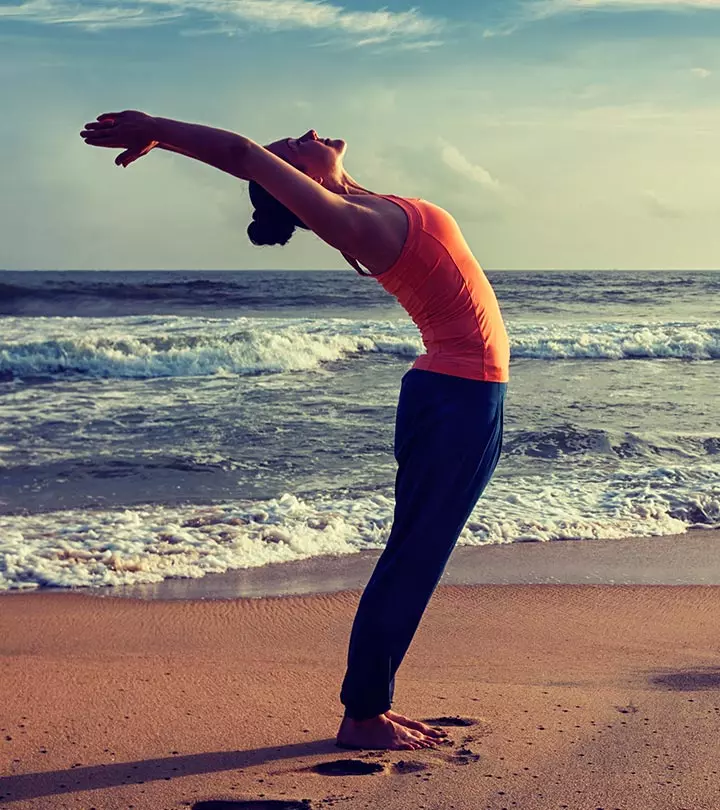
Image: ShutterStock
It is tough to imagine life on mother Earth without the Sun. For this reason, people pay respect and show gratitude to the Sun in the form of Surya Namaskar or Sun Salutation in Hinduism. The best part is that this age-old tradition has many well-known beneficial aspects.
Surya Namaskar has historical roots in ancient Indian customs, specifically in the Hatha Yoga tradition. Its origins can be found in the Vedic era, when the sun was worshiped as a deity. However, Suryanamaskar is thought to have been created and spread by the King of Aundh, Late Shrimant Balasaheb Pant Pratinidhi, in the 1920s, and later by Sri K V Iyer (a gymnast and bodybuilder, who advocated the combination of yoga and exercise for good health) and Sri Krishnamacharya (an Indian yoga teacher and ayurvedic healer).
According to ancient yogis, different parts of our body are controlled by different divine impulses of light. Surya Namaskar is a set of asanas that form a comprehensive exercise routine. Repeating them 12 times (sets) is equivalent to doing 288 effective yoga asanas within a short span of 12 to 15 minutes.
Besides, the Sun Salutation also acts as a foundation before going ahead with the intense yoga postures. In this article, we explore the benefits of Surya Namaskars and how to do them like a pro. Keep reading for more info!
 Fun Fact
Fun FactIn This Article
Everything You Need To Know About Surya Namaskaras
Why Is The Sun Salutation Good For You?
When you practice the Sun Salutation regularly, you notice some exceptional benefits all over your body. The intense and powerful asanas in the practice have an incredible impact on the stomach, liver, heart, intestines, chest, throat, and legs, which means the whole body from head to toe is benefited. The Sun Salutation also improves and enhances blood circulation throughout the body, and this ensures the proper functioning of the bowels, the stomach, and the nerve centers. When you practice this routine every day, the Vatai The pioneer of the three doshas that govern the movements in the mind and body and are composed of air and space. , Pittai One of the body's three doshas or elemental energies that controls metabolism, digestion, and energy production. , and Kaphai The third component of the three doshas that is composed of earth and water and concerns itself with nourishment and growth. are also balanced.
How Many Calories Do You Lose In A Single Set Of Surya Namaskaras?
A single round of Surya Namaskaras helps you burn up to 13.90 calories for someone who is of average weight. With this as a primary benchmark, you can decide how many sets to do. With practice, you should ideally be able to do 108. And as you strive to reach that number, you will automatically become fit and toned.
How Many Calories Are You Burning In Your 30 Minute Workout?
To give you the larger picture, take a look at how many calories you burn in 30 minutes of different workouts.
Weightlifting – 199 calories
Tennis – 232 calories
Basketball – 265 calories
Beach Volleyball – 265 calories
Football – 298 calories
Bicycling (14 – 15.9 mph) – 331 calories
Rock Climbing – 364 calories
Running (7.5mph) – 414 calories
Surya Namaskar – 417 calories
*Data Courtesy: Sri Sri Ravi Shankar, Artofliving.org*
To Know How It helps to reach your Burning Calories Target:
How Calories Will Burn In Surya Namaskar
What Must You Know Before You Start Off With The Asanas?
The best time to practice the Sun Salutation is early in the morning when the sun is rising. You must make sure your stomach and bowels are empty.
However, some might ask if the Sun Salutation can be practiced in the evening as well. Yes, it can! Surya Namaskaras can be practiced at sunrise and sunset. But if you want to practice after sunset, it is no longer Sun Salutation, it becomes Moon Salutation or Chandra Namaskaras, and includes one more asana. This can be practiced when the moon is out and visible.
There is no restriction on a place to practice these asanas. However, it is always more enjoyable to practice these asanas outdoors and in harmony with nature, or in a fully ventilated room.
You must also learn to listen to your body. Do not overstretch as a beginner. It is always advisable to practice this asana under the supervision of a certified yoga instructor.
Ideally, you should practice at least 12 rounds of the Surya Namaskaras Every Day, which means six sets on the right leg, and six sets on the left leg. However, if you are a beginner, it is best you start with four sets, and then gradually increase the number of sets. Surya Namaskaras usually begin with a prayer in reverence to the Sun for being the source of energy.
These are 12 Mantras for the 12 sets that are typically practiced.
Om Mitraya Namah
Om Ravaye Namah
Om Suryaya Namah
Om Bhanave Namah
Om Khagaya Namah
Om Poosne Namah
Om Hiranyagarbhaya Namah
Om Marichaya Namah
Om Adityaya Namah
Om Savitre Namah
Om Arkaya Namah
Om Bhaskaraya Namah
How To Do The Surya Namaskaras?
Here is the detailed insight of 12 steps on how to do Surya Namaskar yoga. Different teachers have different ways of teaching this sequence. Some incorporate other asanas in the sequence to make it a more intense workout. The others stick to the basics. Either way, there is no hard and fast rule or fixed time that you must stay in each asana. However, about 30 seconds in each asana is ideal. Alter your breathing as instructed in each step.
Step 1 – The Pranamasana Or The Prayer Pose
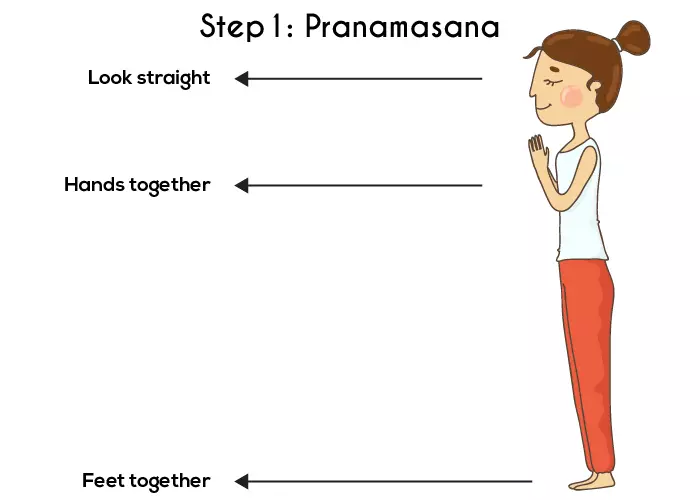
To Do This Pose:
Start the Surya Namaskaras by standing at the edge of your mat. Keep your feet together, and make sure your weight is equally balanced on both the feet. You must now relax your shoulders and expand your chest. Inhale and lift both your arms up. Then, exhale, and bring your palms in front of your chest in a prayer position.
Step 2 – Hasta Uttanasana Or The Raised Arms Pose

To Do This Pose:
Inhale Lift your arms up and back, making sure your biceps are close to your ears. Your effort through this pose must be to stretch your whole body, right from the heels to the tips of the fingers.
Step 3 – Pada Hastasana Or Hand To Foot Pose

To Do This Pose:
Exhale and bend forward from the waist. You must ensure your spine is erect. As you inhale, bring your hands down on the floor and beside the feet.
This asana is also called the Uttanasana. Know More: The complete Guide To Uttanasana
Step 4 – Ashwa Sanchalanasana Or The Equestrian Pose
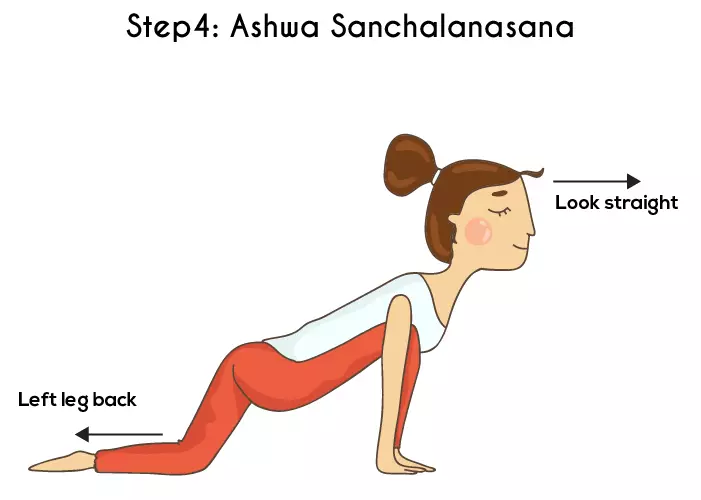
To Do This Pose:
Now, Inhale, and push your Left Leg back, as far as you possibly can. Bend your Right Knee, and place your arms next to your feet. Turn your gaze forward.
Step 5 – Parvatasana Or Mountain Pose

To Do This Pose:
Exhale, and lift up your hips and tailbone. Your chest must face downwards to form an inverted V.
This asana is also called the Adho Mukha Svanasana. Know More: The Complete Guide Adho Mukha Svanasana
Step 6 – Ashtanga Namaskara Or The Salute With Eight Parts
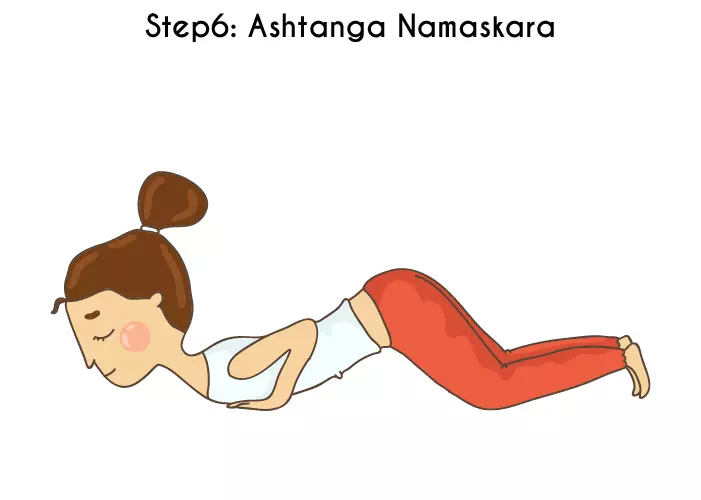
To Do This Pose:
Gently bring your knees down to the floor, and Exhale. Take your hips back, and slide forward, such that your chin and chest rest on the floor. Raise your buttocks slightly. You will notice that the hands, feet, knees, chest, and chin touch the floor. Eight parts in total.
Step 7 – Bhujangasana Or The Cobra Pose
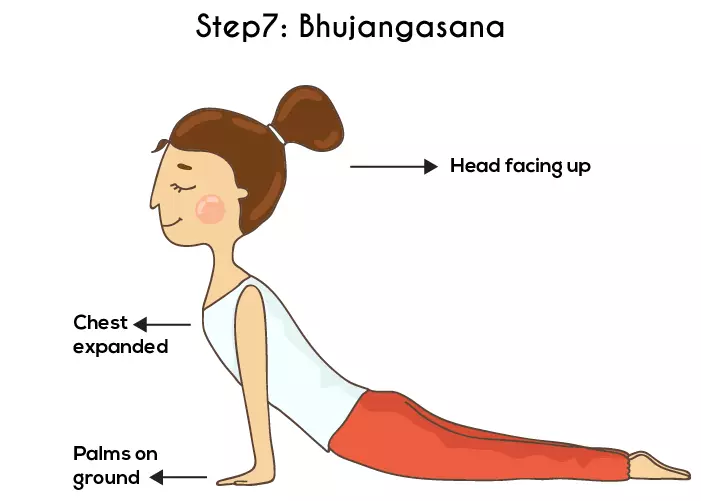
To Do This Pose:
Now, slide your body forward. Raise your chest up in the Cobra Pose. Your elbows must be bent, and your shoulders must be placed away from the ears. Turn your gaze upwards.
Step 8 – Parvatasana Or The Mountain Pose
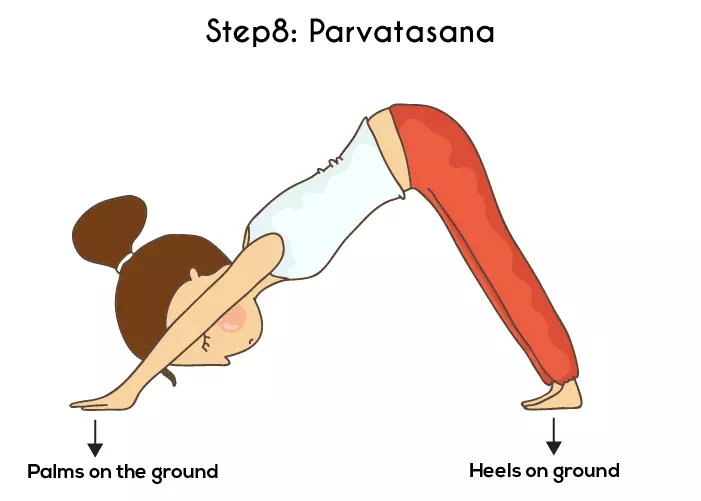
To Do This Pose:
Exhale, and lift up your hips and tailbone. Your chest must face downwards to form an inverted V.
Step 9 – Ashwa Sanchalanasana Or The Equestrian Pose
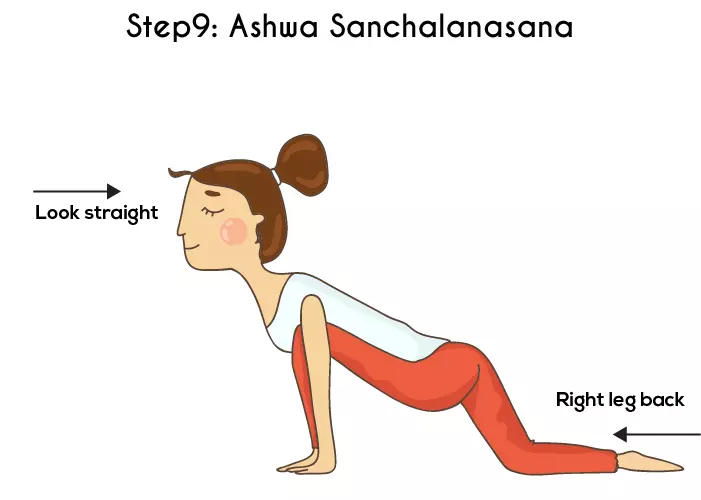
To Do This Pose:
Inhale, and push your Right Leg back, as far as you possibly can. Bend your Left Knee, and place your arms next to your feet. Turn your gaze forward.
Step 10 – Pada Hastasana Or Hand To Foot Pose
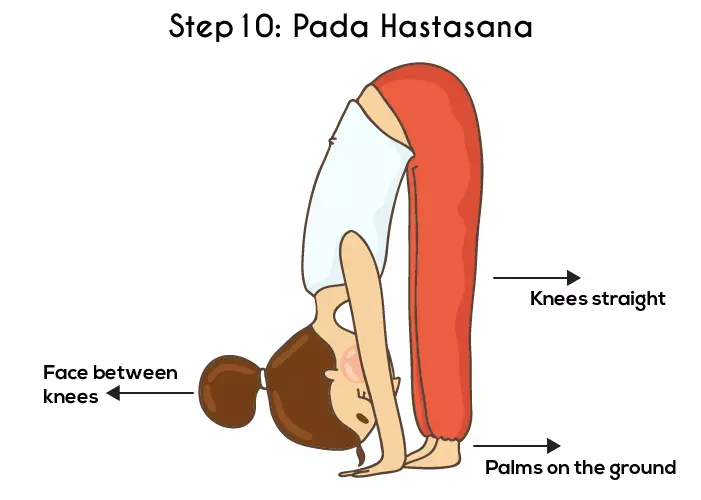
To Do This Pose:
Exhale, and bend forward from the waist. You must ensure your spine is erect. As you Inhale, bring your hands down on the floor and beside the feet. Exhale.
Step 11 – Hasta Uttanasana Or The Raised Arms Pose
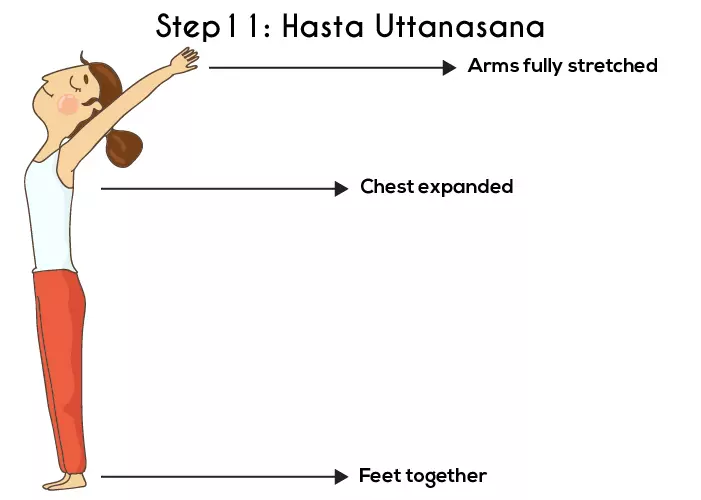
To Do This Pose:
Inhale, and lift your arms up and back, making sure your biceps are close to your ears. Your effort through this pose must be to stretch your whole body, right from the heels to the tips of the fingers.
Step 12 – The Pranamasana Or The Prayer Pose
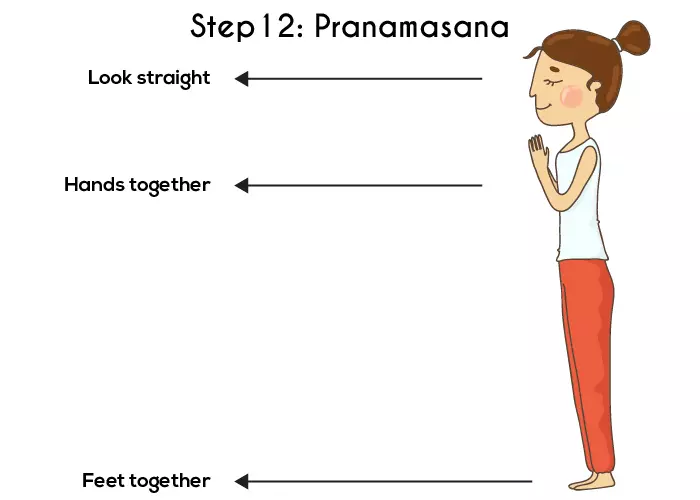
To Do This Pose:
Keep your feet together, and make sure your weight is equally balanced on both the feet. You must now relax your shoulders and expand your chest. Inhale and lift both your arms up. Then, exhale and bring your palms in front of your chest in a prayer position.
In the next section, we will examine variations of Surya Namaskar that will help you become more familiar with this technique.
Key Takeaways
- Surya Namaskar is a set of asanas, which performed 12 times is equivalent to doing 288 yoga asanas within 15 minutes.
- They impact the whole body and routine practice improves blood circulation, digestion, and nervous activity.
- Plan your daily workout benchmark keeping in mind that you can burn 13.90 calories in one set of asanas.
- Do the sun salutations during sunrise or sunset. If you are doing it at night, add one more asana to complete the Chandra Namaskar.
- Thirty seconds is the ideal time for each asana and try to do 12 sets of Surya namaskar daily.
Variations Of Surya Namaskar
Surya Namaskar comes in a variety of forms to suit varying skill levels and capabilities. The most popular varieties, which are often seen in Ashtanga and Vinyasa yoga styles, are Surya Namaskar A and Surya Namaskar B.
- Surya Namaskar A: This variant has 12 fundamental postures and is a more straightforward, foundational sequence. It is an excellent way to introduce the practice to beginners, and it helps them build a connection between breathing and movement.
- Surya Namaskar B: A more complex variation, Surya Namaskar B includes extra poses such as Virabhadrasana I (Warrior I Pose) and Utkatasana (Chair Pose). Since it is more dynamic and demands more strength and stamina, it is appropriate for intermediate and advanced practitioners.
After knowing the variations of surya namaskar, it is crucial to understand who can actually do it and who should abstain from practicing this integral yoga pose. Read our next section for more information.
Who Should Abstain From Practicing The Surya Namaskaras?
- Pregnant women must refrain from practicing the Surya Namaskaras after their third month of pregnancy.
- Those suffering from herniai The protrusion of an internal organ or body part from its muscle wall or tissue because of an abnormal opening. and high blood pressure should also avoid practicing this sequence.
- Those suffering from back problems should seek proper guidance while practicing this sequence.
- Women must avoid practicing the Sun Salutation while they are on their periods.
 Quick Tip
Quick TipWhat Are The Benefits of Surya Namaskaras?
Practicing this sequence has innumerable benefits. But these are the most common ones.
1. Enhances Blood Circulation In The Body
Throughout the sequence, you inhale and exhale, which means your lungs undergo constant ventilation. Your blood remains fresh and oxygenated. This practice helps to remove the toxins from the body.
2. The Weight Loss Mantra
Many people practice and recommend Surya Namaskar for weight loss and its ability to provide a full-body workout. When this asana is done at a fast pace, it becomes a cardio routine. Therefore, it helps you lose weight and also tones your abs and arms. Your spine attains greater flexibility and strength, and it also strengthens your skeletal system.
3. Facilitates A Regular Menstrual Cycle
If you have an irregular menstrual cycle, this routine will balance out and regulate your periods. If practiced regularly, it also ensures ease in childbirth.
Sayali Kasar, a health and lifestyle blogger, shares how performing 108 Surya Namaskar has benefitted her in several ways, including helping her reduce her period cramps. She says, “My periods are regular but come bearing pains and cramps. Recently that has reduces significantly owing to this exercise as Suryanmaskar [which] is known to restore hormonal balance in the body. It also strengthens the smooth muscles and hence reduce[s] the cramps (i).”
4. It Betters Your Skin and Hair
This sequence keeps your health and beauty, no matter your age. It enhances your blood circulation, and therefore, imparts a healthy glow on your face. It delays the signs of aging and keeps the wrinkles at bay. This sequence also prevents hair loss and graying of hair.
5. Anti-anxiety and Calming Properties
The Surya Namaskar poses improve memory and enhance the nervous system. The sequence also stabilizes the activity of the thyroid and endocrine glands. Therefore, it reduces stress and anxiety and promotes calmness.
6. May Boost Gut Health
Surya Namaskar offers benefits beyond physical fitness and has a positive effect on your gut health. This practice involves various poses and focuses on controlling your breathing. It may help enhance digestion and alleviate common gastrointestinal issues such as gas and bloating. The abdominal organs gently stretch and compress while doing this pose, and this helps massage the digestive tract to promote better nutrient absorption and smoother digestion. Regular practice also reduces stress, another major cause of gut problems. In turn, stress reduction can enhance the gut-brain connection and improve one’s overall digestive health and wellbeing.
7. Helps In Enhancing Mindfulness
Surya Namaskara is a practice that relies heavily on breath control, or pranayama. Each movement is planned to correspond with an inhalation or exhalation, enhancing mental clarity and energy flow. Many practitioners also include chanting mantras, which strengthen the spiritual bond and turns the sequence into a meditative experience that encourages inner serenity and mindfulness.
Infographic: Tips To Enhance Surya Namaskar
With all the basic knowledge about Surya Namaskar in your arsenal, you are all set to try it out and enjoy its benefits. But, did you know that this series of poses can be a wholesome and enriching experience leading you towards spirituality? While the movements themselves can benefit your body, the experience of performing these movements can heal you as well. Check out the infographic below to learn how to perform Surya Namaskar for meditation and to practice mindfulness.
Some thing wrong with infographic shortcode. please verify shortcode syntax
Surya Namaskar or Sun Salutation is an effective way to stay fit, lose weight, improve skin and hair health, and combat anxiety. It also helps boost blood circulation, ease bowel movements, enhance the functioning of the nerve centers, and improve overall wellness.
Each cycle of Surya Namaskar is said to help burn 14 calories. Performing it in the mornings is ideal when your bowels and stomach are empty. However, those with hypertension and pregnant women (post third month) should avoid Sun Salutations, while those with back pain should seek expert guidance.
Frequently Asked Questions
Is it necessary to do Surya Namaskar in front of the sun?
It is better to do Surya Namaskar in front of the sun as the rays may emit positive energies and benefit your body (1).
Does Surya Namaskar reduce the tummy?
Yes, Surya Namaskar can help you reduce stomach fat (2).
How long should one hold each posture in Surya Namaskar?
The duration for holding each posture in Surya Namaskar can vary depending on fitness level and flexibility. Generally, one can maintain each posture for about 3-5 deep breaths to attain proper alignment and focus on breathing while performing the sequence.
What are the disadvantages of Surya Namaskar?
While Surya Namaskar is generally a safe and beneficial yoga practice, some potential disadvantages could be fatigue, breathlessness, dizziness, physical strain and the risk of injury if done incorrectly or without proper warm-up and preparation. It may not be suitable for pregnant women and people with high blood pressure or heart conditions. In case of any underlying health conditions, injuries, or physical limitations, one must consult a qualified yoga practitioner or a healthcare professional before attempting Surya Namaskar.
Some thing wrong with illustration image shortcode. please verify shortcode syntax
Start your yoga journey with this easy to follow step-by-step video guide to Surya Namaskar. Learn the basics of Sun Salutation in just 3 minutes!
Personal Experience: Source
StyleCraze's articles are interwoven with authentic personal narratives that provide depth and resonance to our content. Below are the sources of the personal accounts referenced in this article.
i. How I completed a 108 Surya Namaskarhttps://medium.com/@sayalikasar/how-i-completed-a-108-suryanamaskar-b62c63460572
References
Articles on StyleCraze are backed by verified information from peer-reviewed and academic research papers, reputed organizations, research institutions, and medical associations to ensure accuracy and relevance. Read our editorial policy to learn more.
- Impact of Surya Namaskar on the Human System
https://www.rroij.com/open-access/impact-of-surya-namaskar-on-the-human-system-.php?aid=80420 - Surya Namaskar: A way to Healthy Life
https://www.worldwidejournals.com/indian-journal-of-applied-research-(IJAR)/recent_issues_pdf/2013/February/February_2013_1360406998_59ba9_100.pdf
Read full bio of Pratibha Agarwal
Read full bio of Shirin Mehdi
Read full bio of Ravi Teja Tadimalla
Read full bio of Himanshi Mahajan






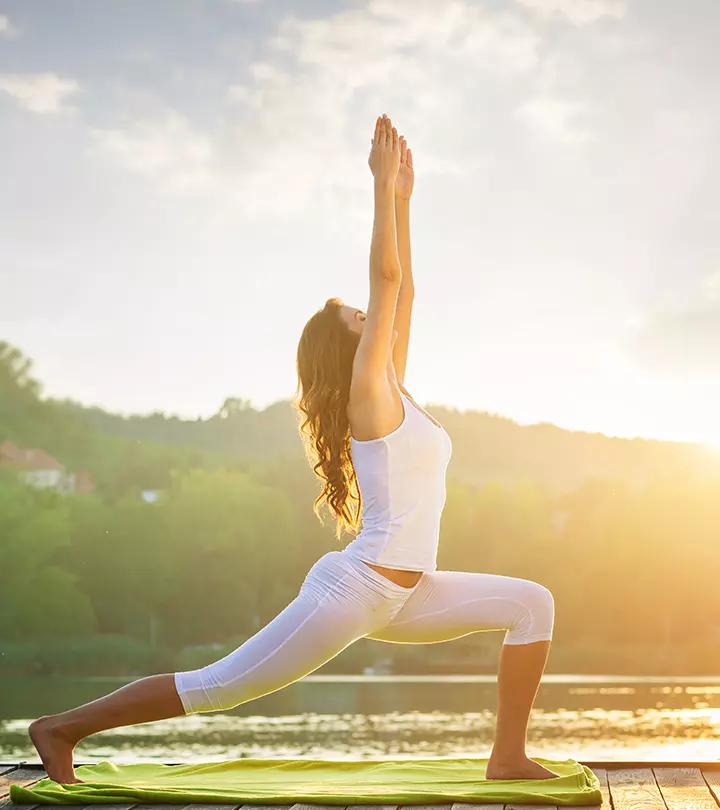
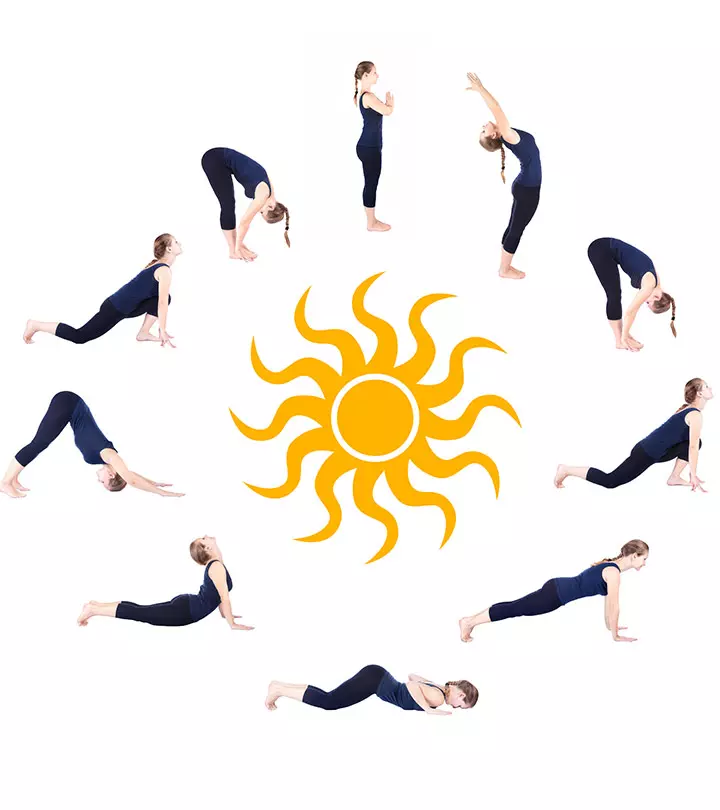




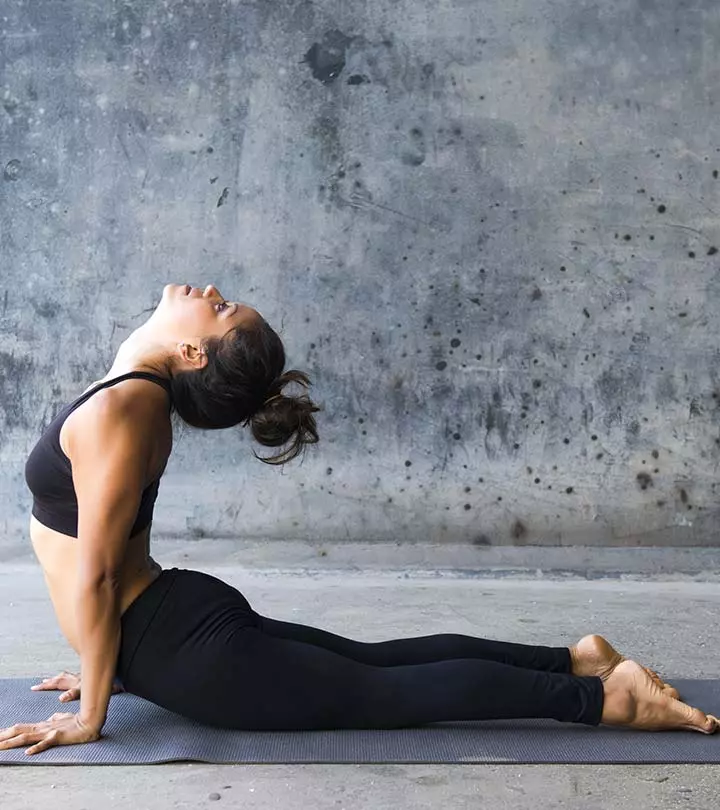

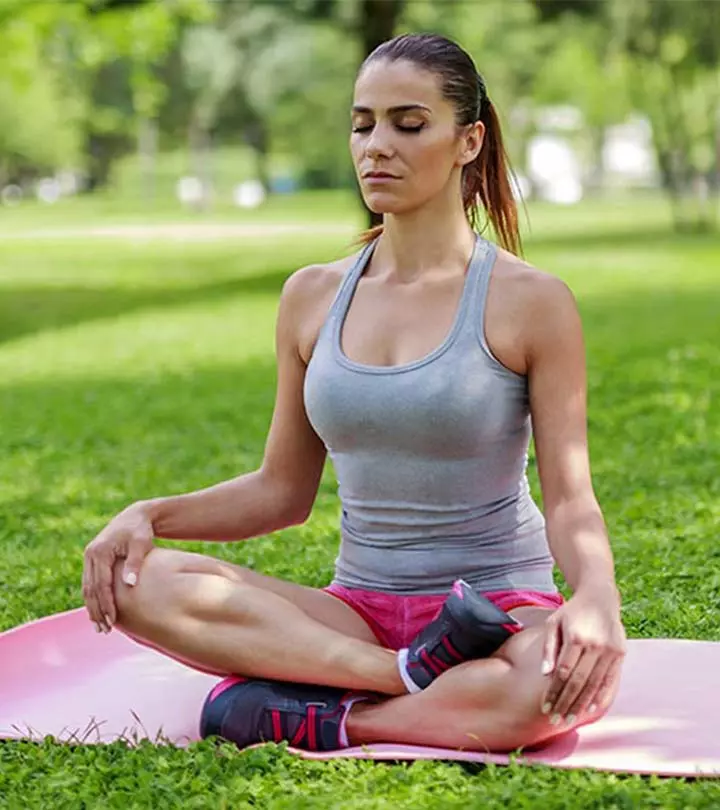

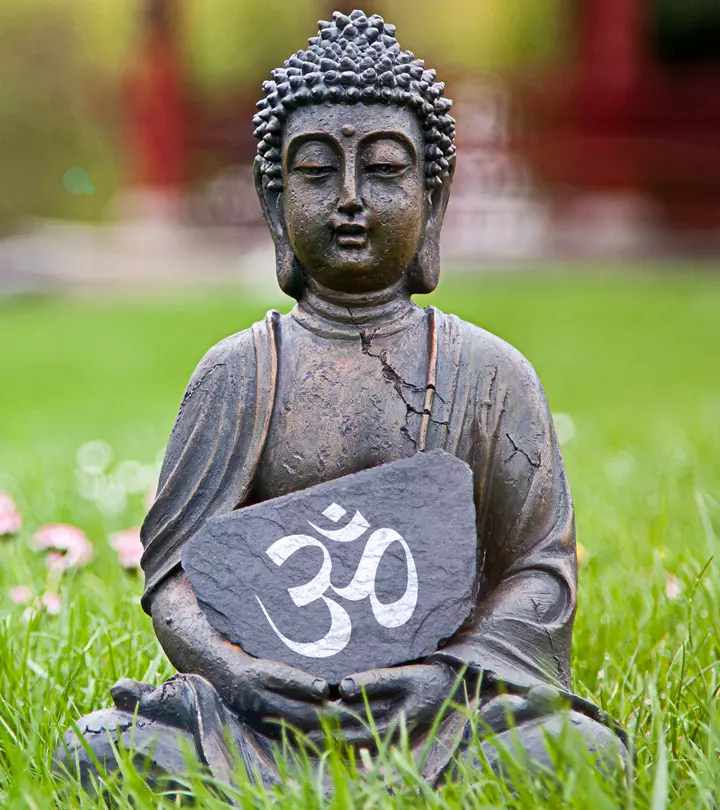
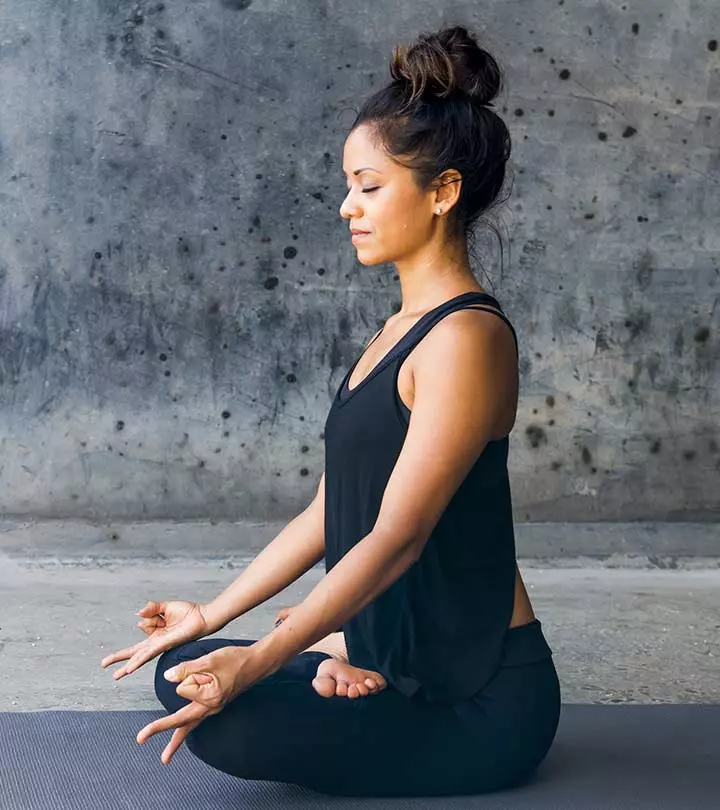
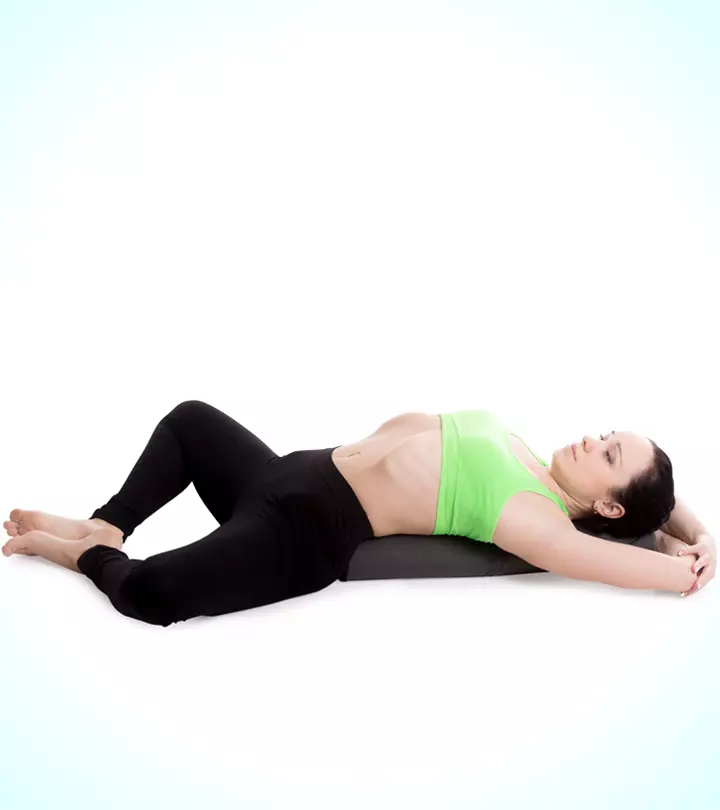
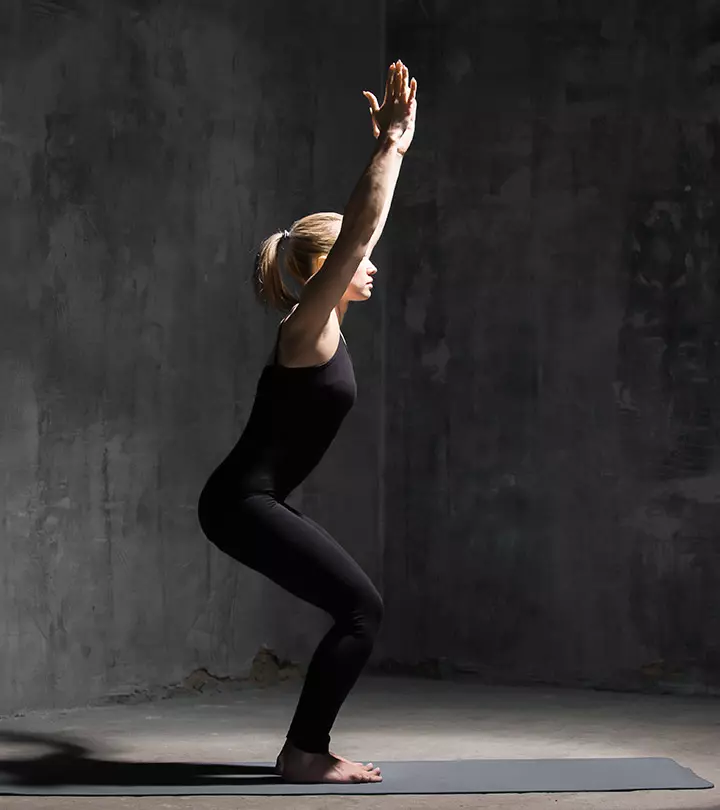

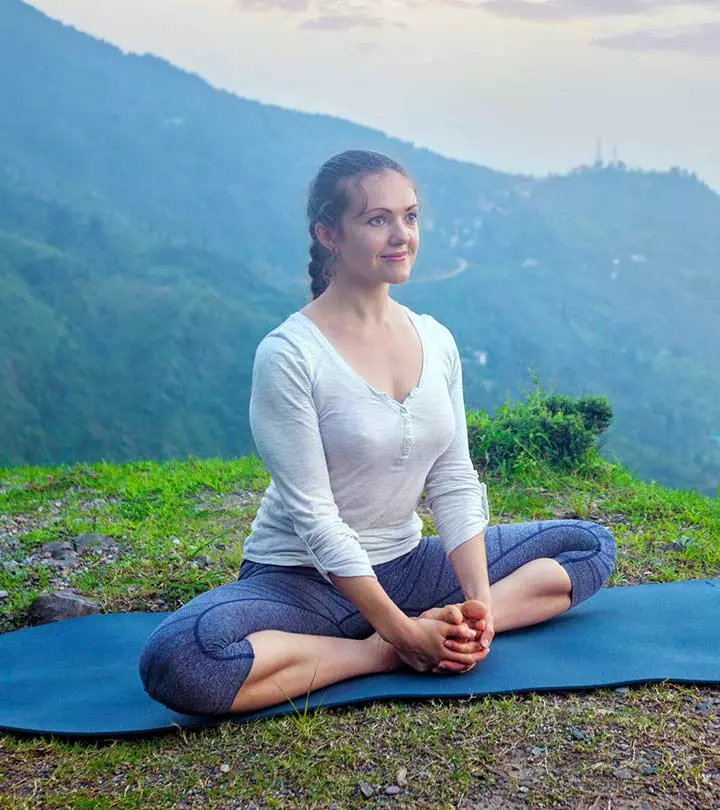

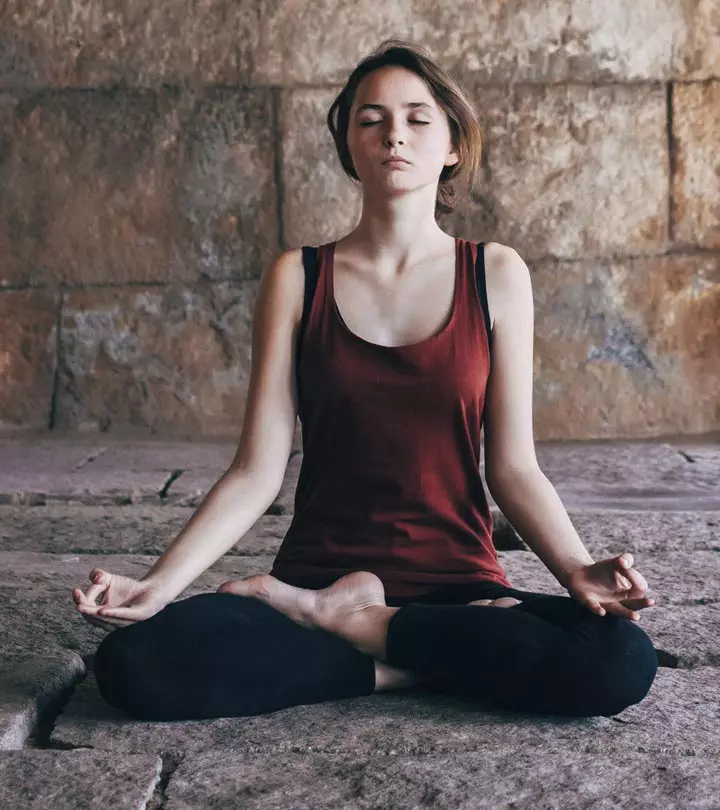

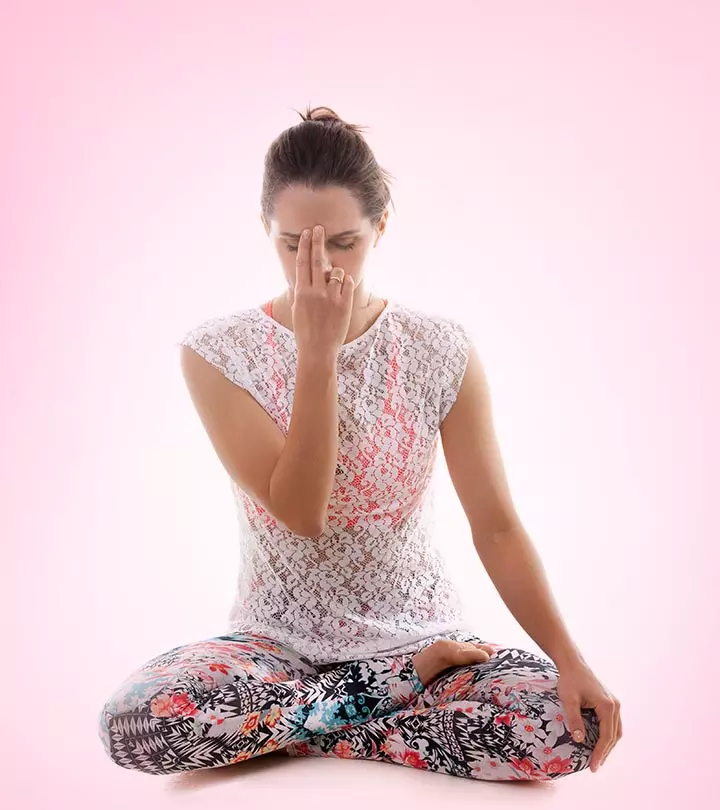
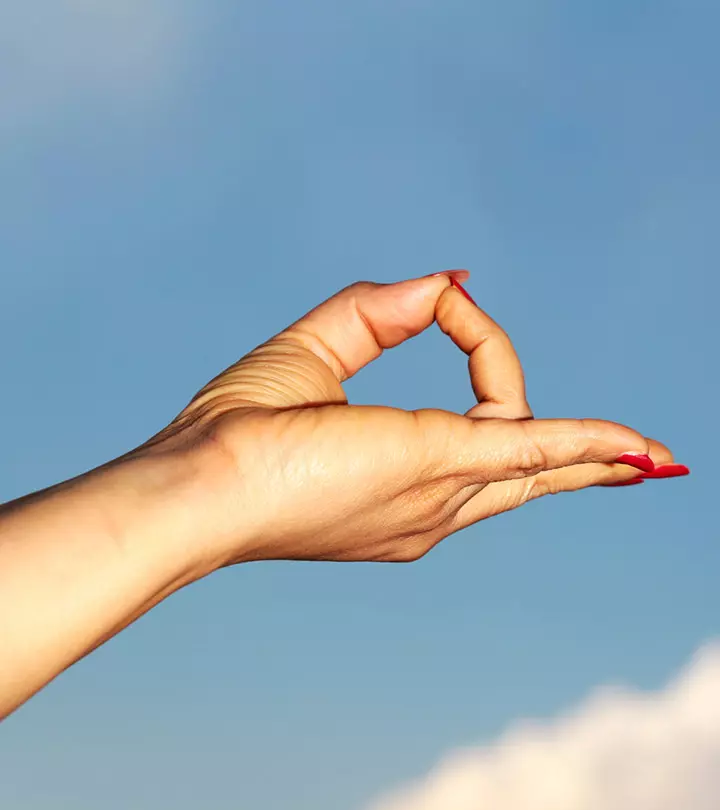
Community Experiences
Join the conversation and become a part of our empowering community! Share your stories, experiences, and insights to connect with other beauty, lifestyle, and health enthusiasts.